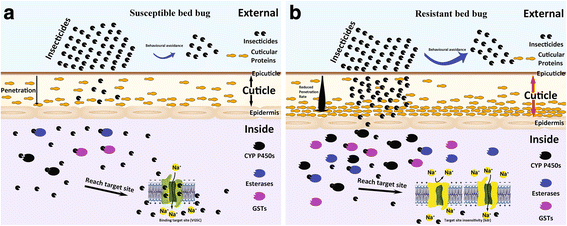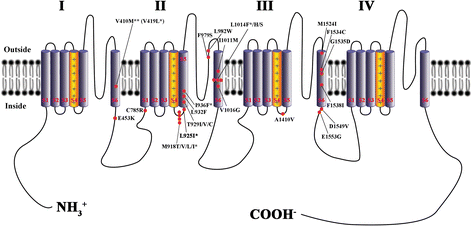Insecticide resistance and resistance mechanisms in bed bugs, Cimex spp. (Hemiptera: Cimicidae)
- PMID: 28662724
- PMCID: PMC5492349
- DOI: 10.1186/s13071-017-2232-3
Insecticide resistance and resistance mechanisms in bed bugs, Cimex spp. (Hemiptera: Cimicidae)
Abstract
The worldwide resurgence of bed bugs [both Cimex lectularius L. and Cimex hemipterus (F.)] over the past two decades is believed in large part to be due to the development of insecticide resistance. The transcriptomic and genomic studies since 2010, as well as morphological, biochemical and behavioral studies, have helped insecticide resistance research on bed bugs. Multiple resistance mechanisms, including penetration resistance through thickening or remodelling of the cuticle, metabolic resistance by increased activities of detoxification enzymes (e.g. cytochrome P450 monooxygenases and esterases), and knockdown resistance by kdr mutations, have been experimentally identified as conferring insecticide resistance in bed bugs. Other candidate resistance mechanisms, including behavioral resistance, some types of physiological resistance (e.g. increasing activities of esterases by point mutations, glutathione S-transferase, target site insensitivity including altered AChEs, GABA receptor insensitivity and altered nAChRs), symbiont-mediated resistance and other potential, yet undiscovered mechanisms may exist. This article reviews recent studies of resistance mechanisms and the genes governing insecticide resistance, potential candidate resistance mechanisms, and methods of monitoring insecticide resistance in bed bugs. This article provides an insight into the knowledge essential for the development of both insecticide resistance management (IRM) and integrated pest management (IPM) strategies for successful bed bug management.
Keywords: Bed bug; Cimex hemipterus; Cimex lectularius; Insecticide resistance; Mechanism; Molecular basis; Resistance monitoring.
Figures


References
-
- Georghiou GP. The evolution of resistance to pesticides. Annu Rev Ecol Syst. 1972;3:133–168. doi: 10.1146/annurev.es.03.110172.001025. - DOI
-
- Lee CY. Insecticide resistance and its underlying mechanisms in the German cockroach, Blattella germanica (Linn.) (Dictyoptera: Blattellidae) J Biosci. 1997;8:156–172.
-
- Liu N, Zhu F, Xu Q, Pridgeon JW, Gao X. Behavioral change, physiological modification, and metabolic detoxification: mechanisms of insecticide resistance. Acta Entomol Sin. 2006;49:671–679.
Publication types
MeSH terms
Substances
LinkOut - more resources
Full Text Sources
Other Literature Sources
Medical
Miscellaneous

